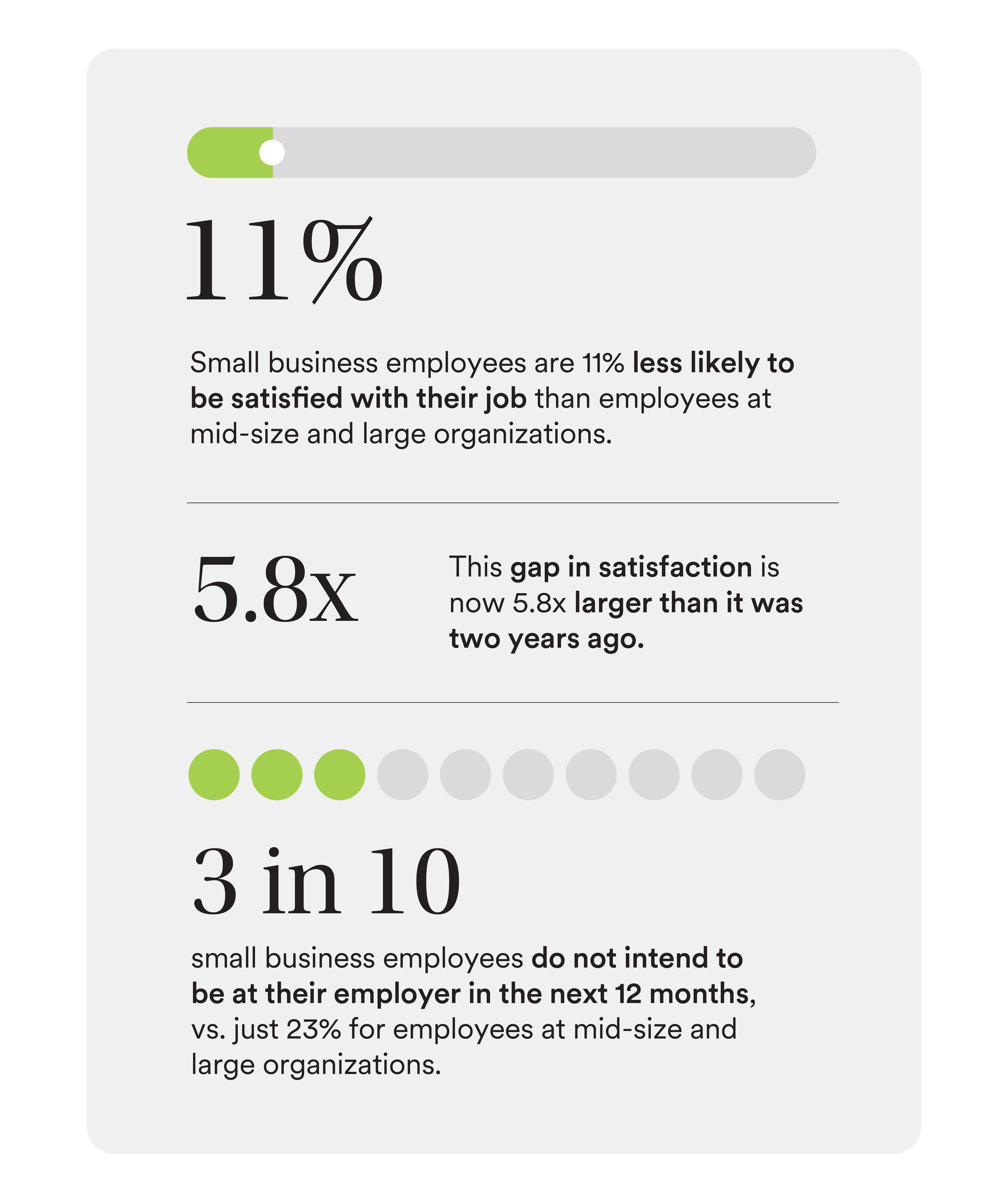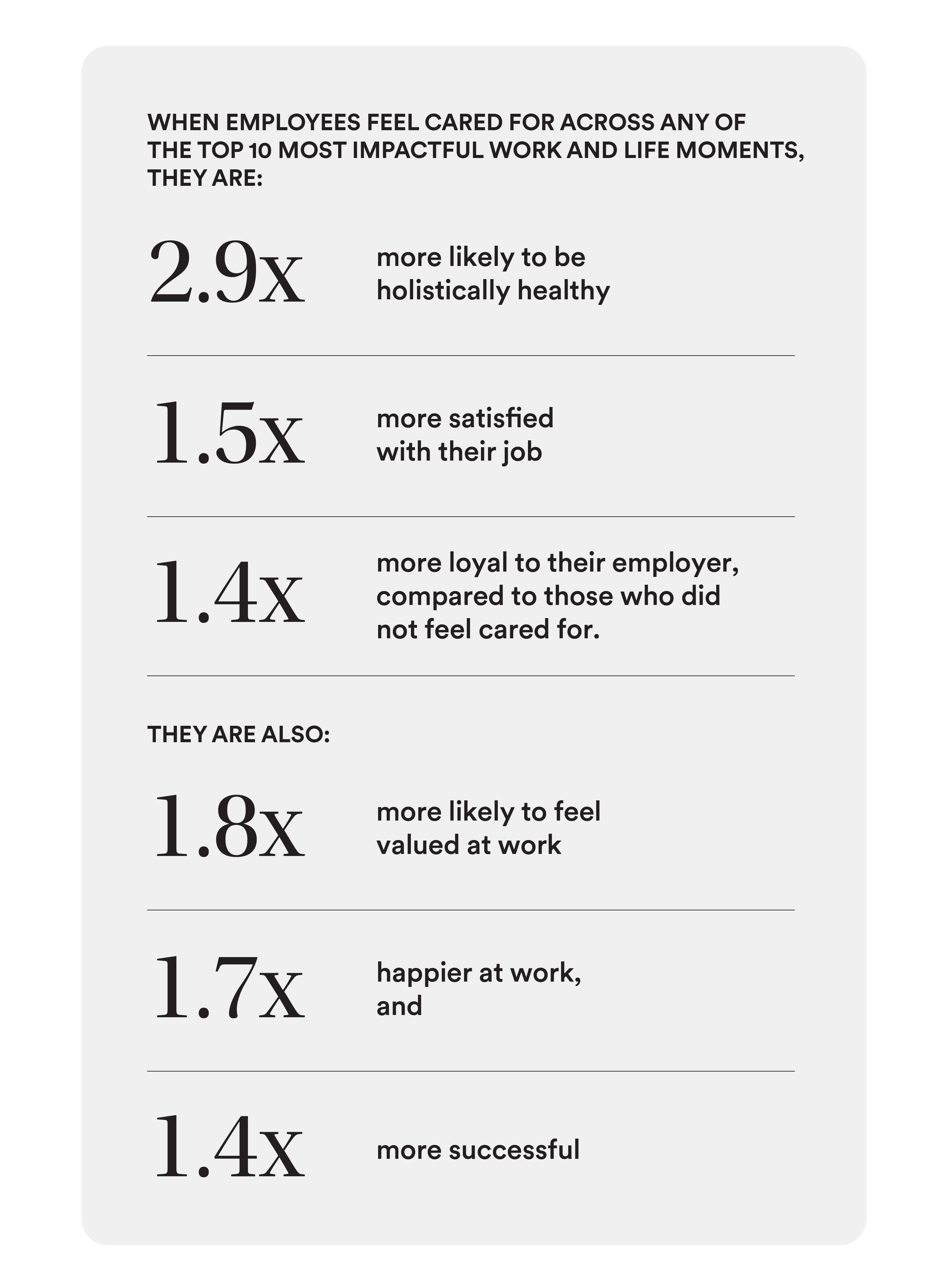The past few years have been challenging ones for many small business employers. Inflation continues to loom large in small business owners’ minds, along with financial pressure to navigate macroeconomic headwinds.
At the same time, generational shifts continue to impact employee-employer dynamics. And, in an era of “quiet quitting” and “acting your wage,” employers are looking for new strategies to cultivate a happy, productive workforce.
Unfortunately, job satisfaction and loyalty are slipping among small business employees
More than one in five small business employers (21%) cite employee retention and satisfaction as their top business concern — and, unfortunately, many small businesses have reason to worry. While job satisfaction and loyalty at mid-size and large competitors saw an uptick over the past two years, they’ve remained flat for small businesses:
Small business employees are 11% less likely to be satisfied with their job than employees at mid-size and large organizations. That gap is 5.8 times larger than it was two years ago. Three in 10 small business employees do not intend to be with their employer in the next 12 months versus 23% for employees at mid-size and large organizations.
Employee holistic well-being remains stagnant, and financial health is on the decline
These trends may be partially explained by lagging holistic wellness among small business employees. Inflation and the cost of living continue to loom large in employees’ minds. And, while employees at mid-size and large businesses saw their financial health rebound over the past year, small business employees continue to struggle.
Small business employees are 15% less likely to be holistically healthy than employees at larger organizations. Forty five percent of small business employees feel confident regarding their finances, down from 57% in 2022. The gap in financial health between small business employees vs. those at larger organizations is three times larger than it was last year.
Employee care helps small business employers reverse these trends
Although small business employees and employers struggle with unique sets of challenges, their troubles share a common solution: Employee care.
Employee care means taking an active interest in employees’ well-being, both at work and outside of work, and taking a holistic approach to demonstrate care across each element of the employee experience.
Employee care was first explored in our 2023 Employee Benefit Trends Study report as a strategy to enhance outcomes for both employees and employers. This year’s report builds on the MetLife Care Model, contextualizing care throughout the employee journey and exploring how employers can best demonstrate care during employees' lives — even in challenging moments, such as losing a friend, that may not be visible to employers.
To this end, we examined 55 life and work moments to identify the moments with the greatest impact on small business employees, as well as moments where employers have an opportunity to demonstrate greater care.
Small business employees’ top 10 most impactful moments across life and work:
- Loss of family member / friend
- Becoming primary income-earner
- Growing your family
- Significant unplanned financial stress/expense
- Experience burnout
- Pregnancy
- Bereavement (including miscarriage)
- Promotion
- Caregiving responsibilities for adult family member / friend
- Victim of cyber fraud (e.g., identity theft)
Crucially, we discovered that delivering care during these key moments can be truly transformational for improving outcomes for employees and employers alike:
When employees feel cared for across the top ten most impactful work and life moments, they are 2.9 times more likely to be holistically healthy, 1.5 times more satisfied with their job, and 1.4 times more loyal to their employer. They are also 1.8 times more likely to feel valued at work, 1.7 times happier at work, and 1.4 times more successful.
Finally, we learned that, while small businesses increasingly recognize the value in demonstrating care, employees still crave more support than they’re currently receiving — particularly during challenging work and life moments.
With these insights, businesses can focus their efforts on demonstrating care when it matters most, leveraging strategies demonstrated to be most effective for small business employees.
Learn how to boost job satisfaction, loyalty and employee well-being with always-on care
This year's Small Business report - powered by research from MetLife's 22nd Annual Employee Benefit Trends Study - explores what it means to provide always-on care. We’ll share insights into how to leverage benefits to demonstrate care across the employee experience, as well as detailed strategies to “meet the moment” during the work and life moments when small business employees crave more care.
To learn how to bolster productivity, retention and other key talent metrics with always-on employee care, read the report.




